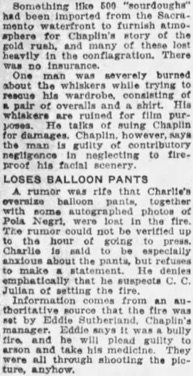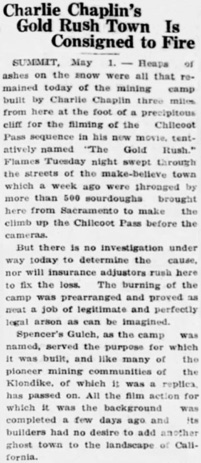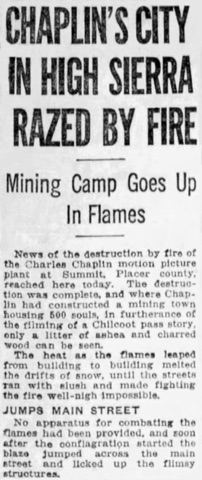The Gold Rush 1924 1925 1926 next previous
The Gold Rush Clippings 81/363
Los Angeles Evening Express, California, May 3, 1924.
Charlie Chaplin‘s Gold Rush Town
Is Consigned to Fire
SUMMIT, May 1. – Heaps of ashes on the snow were
all that remained today of the mining camp built
by Charlie Chaplin three miles from here at the foot
of a precipitous cliff for the filming of the Chilcoot
Pass sequence in his new movie, tentatively named „The Gold
Rush.“ Flames Tuesday night swept through the
streets of the make-believe town which a week ago were
thronged by more than 500 sourdoughs brought
here from Sacramento to make the climb up the Chilcoot
Pass before the cameras.
But there is no investigation under way today to determine
the cause, nor will insurance adjustors rush here
to fix the loss. The burning of the camp was prearranged
and proved as neat a job of legitimate and perfectly
legal arson as can be imagined.
Spencer‘s Gulch, as the camp was named, served
the purpose for which it was built, and like many
of the pioneer mining communities of the Klondike, of which
it was a replica, has passed on. All the film action
for which it was the background was completed a few days
ago and its builders had no desire to add another
ghost town to the landscape of California.
(...) Morning Union, Grass Valley, California, May 2, 1924
„They were all through shooting the picture, anyway“
Editorial content. „CHAPLIN‘S CITY IN HIGH SIERRA
RAZED BY FIRE
Mining Camp Goes Up
In Flames
News of the destruction by fire of the Charles Chaplin
motion picture plant at Summit, Placer county,
reached here today. The destruction was complete,
and where Chaplin had constructed a mining
town housing 500 souls, in furtherance of the filming
of a Chilcoot pass story, only a litter of ashes
and charred wood can be seen.
The heat as the flames leaped from building to building
melted the drifts of snow, until the streets ran
with slush and made fighting the fire well-nigh impossible.
JUMPS MAIN STREET
No apparatus for combating the flames had been
provided, and soon after the conflagration started
the blaze jumped across the main street and licked up the
flimsy structures.
Something like 500 ,sourdoughs‘ had been imported
from the Sacramento waterfront to furnish atmosphere
for Chaplin‘s story of the gold rush, and many of these lost
heavily in the conflagration. There was no insurance.
One man was severely burned about the whiskers while
trying to rescue his wardrobe, consisting of a pair
of overalls and a shirt. His whiskers are ruined for film
purposes. He talks of suing Chaplin for damages.
Chaplin, however, says the man is guilty of contributory
negligence in neglecting to fire-proof his facial
scenery.
LOSES BALLOON PANTS
A rumor was rife that Charlie‘s oversize balloon pants,
together with some autographed photos of Pola
Negri, were lost in the fire. The rumor could not be verified
up to the hour of going to press. Charlie is said
to be especially anxious about the pants, but refuses to make
a statement. He denies emphatically that he suspects
-
C.C. Julian of setting the fire.
Information comes from an authoritative source that
the fire was set by Eddie Sutherland, Chaplin‘s
manager. Eddie says it was a bully fire, and he will plead
guilty to arson and take the medicine. They were
all through shooting the picture, anyway.“
More about the cafe fight between Chaplin and C. C.
Julian see Los Angeles Times, Jan. 22, 1924,
Jan. 23, 1924 and Jan. 24, 1924.
Redaktioneller Inhalt
The Gold Rush 1924 1925 1926 next previous



